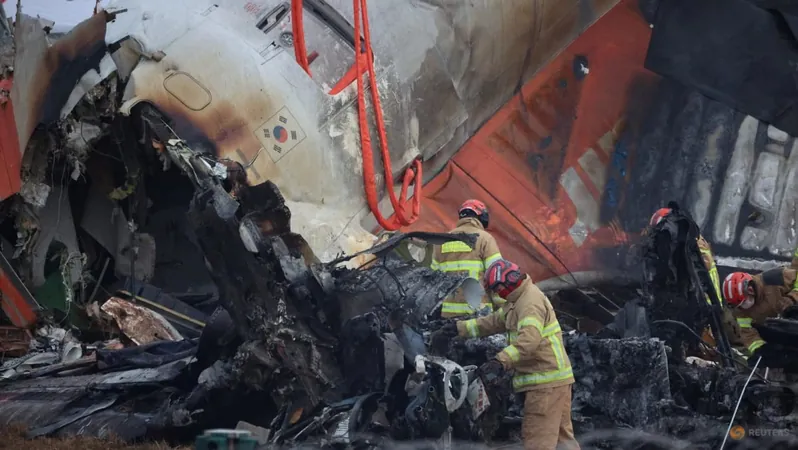
Devastating Jeju Air Plane Crash in South Korea: What We Know So Far
2024-12-30
Author: Siti
SEOUL: A tragic incident unfolded on Sunday, December 29, when a Jeju Air Boeing 737-800 aircraft, carrying 181 individuals, crashed during its landing approach to Muan airport after a flight from Bangkok. The heartbreaking outcome saw 179 lives lost, with only two fortunate survivors being rescued from the wreckage.
How Did the Disaster Occur?
According to reports, the aircraft was warned by the control tower of a potential bird strike during its initial landing attempt shortly after 9 AM local time. Moments later, an urgent "mayday" call was issued by the pilot as they attempted a second landing. Disturbing video footage captured the plane gliding along the runway on its belly, smoke billowing behind it, until it tragically collided with a wall and erupted into flames.
Authorities have confirmed that all 175 passengers and four of the six crew members aboard perished in the crash. Among the victims were travelers ranging in age from three to 78, with the majority being Korean nationals and two Thais. The two survivors — both female flight attendants aged 25 and 33 — were miraculously pulled from the rubble.
Investigation Findings
As investigations commence, preliminary speculations point toward a bird strike and adverse weather conditions as potential causes of this catastrophic event. Aviation expert Philip Butterworth-Hayes has emphasized that the loss of life in this incident is likely the result of “a series of catastrophic events.” He noted that modern aircraft are equipped with robust safety systems, making this crash one of the most severe he has witnessed in recent years.
While officials assessed the runway's length of 2,800 meters (approximately 9,200 feet) as sufficient for an aircraft of this size, the totality of predefined safety measures appeared to fail in this circumstance.
Fortunately, both the flight data recorder and cockpit voice recorder have been recovered, offering crucial insights into the events leading up to the crash.
The Dangers of Bird Strikes
Bird strikes can pose significant risks to aircraft, as ingestion of birds into engines can result in a loss of power. These incidents, although rare, have led to tragic outcomes in the past. Notable examples include the "Miracle on the Hudson" in 2009, where a US Airways Airbus A320 successfully ditched in the Hudson River following an engine failure caused by a bird strike.
Emergency Response and Rescue Operations
In the aftermath of the crash, hundreds of firefighters, emergency responders, and military personnel were dispatched to the site, with the area designated as a special disaster zone by the acting president of South Korea. Family members, many overwhelmed with grief, anxiously awaited information about their loved ones at the airport.
South Korea’s Aviation Safety Record
Historically, South Korea boasts a commendable aviation safety record, and this incident marks the first fatal accident involving Jeju Air. Previous mishaps have been generally non-fatal, with the most significant prior event involving strong winds causing a plane to veer off the runway in 2007, injuring a dozen individuals.
Notably, the deadliest airplane crash in South Korean history occurred on April 15, 2002, when an Air China flight tragically collided with a hill near Busan-Gimhae, claiming 129 lives. The most recent aviation tragedy occurred on July 6, 2013, in San Francisco, involving Asiana Airlines, which resulted in three fatalities.
This latest tragedy serves as a stark reminder of the inherent dangers of air travel, even in an industry known for its stringent safety protocols. As investigations continue, the aviation community and the public alike will be looking for answers and further developments related to this devastating crash.


 Brasil (PT)
Brasil (PT)
 Canada (EN)
Canada (EN)
 Chile (ES)
Chile (ES)
 Česko (CS)
Česko (CS)
 대한민국 (KO)
대한민국 (KO)
 España (ES)
España (ES)
 France (FR)
France (FR)
 Hong Kong (EN)
Hong Kong (EN)
 Italia (IT)
Italia (IT)
 日本 (JA)
日本 (JA)
 Magyarország (HU)
Magyarország (HU)
 Norge (NO)
Norge (NO)
 Polska (PL)
Polska (PL)
 Schweiz (DE)
Schweiz (DE)
 Singapore (EN)
Singapore (EN)
 Sverige (SV)
Sverige (SV)
 Suomi (FI)
Suomi (FI)
 Türkiye (TR)
Türkiye (TR)
 الإمارات العربية المتحدة (AR)
الإمارات العربية المتحدة (AR)